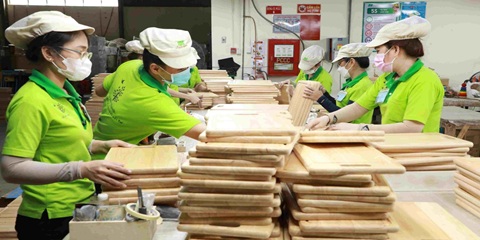Want to be in the loop?
subscribe to
our notification
Business News
LABOUR QUALITY SHOULD BE IMPROVED TO SHARPEN COMPETITIVENESS
[23-11-2015] In the newsletter on Labour market published by the Ministry of Labour, Invalids and Social Affairs (MOLISA) in collaboration with the Vietnam General Statistics Office recently, indicators of market prospects and demand for labour from now until the end of 2015 were released, many of which are very significant indicators.
Along with the development of economy, labour demand generally increases in all types of businesses and services. According to the statistics of the MOLISA, in 2015 the demand for labour in business sector increased by about 360,000 people (up 3.27 percent) compared to 2014, bringing the total number of workers employed in the country up to 12.3 million. It is expected that by the end of 2015 the percentage of waged workers on the total of employed of around 40 percent.
Labour supply, in general throughout the country is still abundant. In Quarter III/2015, labour force in the working age is estimated at 54.31 million (representing 76.01 percent of the population aged 15 or more). Entering Quarter IV/ 2015 this figure is estimated at 54.43 million (representing 76.11 percent of the population aged 15 and over); along with raising the percentage of workers with jobs, the unemployment rate also continued to decline. As of Quarter IV/2015, the unemployment rate was only 2.38 percent. Structure of urban workers increased slightly, accounting for 30.5 percent.
According to figures from published newsletter, in Quarter II/2015 the country had 52.53 million people employed, up by 103,000 people compared to the previous quarter. The Labour movement from rural to urban areas tends to decrease. The number of workers employed in urban areas is about 15.73 million, decreased 663,000 people compared to the first quarter, making the proportion of employment in urban areas fell from 31.26 percent in Quarter I/2015 to 29.94 percent in Quarter II/2015. However, workers with jobs in rural areas increased in Quarter II / 2015 when the region had 36.81 million people employed, up by 766,000 people compared to Quarter I / 2015, making the proportion of employed people in rural areas increased from 68.74 percent in Quarter I / 2015 to 70.06 percent in Quarter II / 2015.
Specifically, the areas having the most increasing workforce are: processing, manufacturing increased by 223,000 people; information and communication 178,000 people; construction 113,000 people; commerce and repair 77,000 people; hired labour for household and household economy 25,000 people. The sectors having the most reduced Labour force are: education and training sector decreased by 181,000 people; agriculture, forestry and fisheries 114,000 people; social and political organizations, defense and security 98,000 people; transport, warehousing 84,000 people. The share of waged employment in total employment continues to rise in Quarter II / 2015 reaches 38.81 percent. Despite slight fluctuations in the proportion of self-employed workers (decrease) Labour and unpaid family workers (increase), overall proportion of vulnerable employment in total employment has remained high (57.09 percent).
On average income of salaried employment in Quarter II/ 2015 decreased by VND435,000 (8.9 percent) from the previous quarter in which women workers have a lower income, but the reduction is higher than with male workers (corresponding to VND334,000 and 576,000 respectively). The Labour force employed in state enterprises had the highest average monthly salary (VND6.15 million / person), the labour force working in the cooperative sector having lowest income levels (VND2.84 million).
According to Mr Doan Mau Diep, Deputy Minister of Labour, Invalids and Social Affairs, in Quarter II / 2015 the biggest bright spot is the rise of the economy has led to lower Labour pressure. Employment in the processing sector rose, but labourers in agriculture, forestry and fishery declined. Many of the programs are implemented effectively, such as: Over 90,000 workers are exported, exceeding the target by 2015, unemployment support policies have been put into practice.
Deputy Minister Doan Mau Diep said, after December 31, 2015, the first 8 sectors will be prioritized to move freely within ASEAN are: accountants, architects, engineers, dentists, doctors, nurses, transport and tourism employees. This will put pressure on the labour market of Vietnam when joining the TPP and ASEAN Economic Community. The drawback of Vietnam’s labour force is low-skilled, this would be very difficult to compete directly with foreign labour.
So the deputy minister stressed Vietnam should focus on improving the quality of human resources; better organizing the labour market; providing information on employment for workers; mastering labour structure to have adjustment and reducing the unemployment rate to prepare for the accession process of ASEAN Community by the end of 2015.
Source: VCCI
Related News

A STELLAR CHRISTMAS AT SOFITEL SAIGON PLAZA
Experience the magic of year-end celebrations in five-star luxury, where Parisian elegance meets Saigon’s festive vibrancy. Discover your Stellar Christmas moments: https://sofitel-saigon-plaza.com/festive-offer-2025

CONSTRUCTION SECTOR POSTS OVER 9% GROWTH IN 2025
Industries under the ministry’s management accounted for an estimated 17.23% of national gross domestic product (GDP), up about 0.17 percentage point from 2024. They contributed around 1.96 percentage points to overall GDP growth, reported the Vietnam News Agency. The contribution helped push Vietnam’s economic growth to above 8% in 2025 and supports the Government’s aim of pursuing double-digit growth in the coming years.

VIETNAM PUTS PUBLIC INVESTMENT DISBURSEMENTS AT VND603.6 TRILLION
Vietnam’s public investment disbursements had amounted to VND603.6 trillion in the year to December 18, equivalent to 66.1% of the plan assigned by the prime minister. According to the Ministry of Finance, actual disbursements by December 11 had totaled VND577.7 trillion, or 63.3% of the prime minister-approved plan of VND913.2 trillion, the Vietnam News Agency reported.

SHINE INTO 2026 AT HOIANA RESORT & GOLF!
This New Year’s Eve, celebrate where the sea meets the sky. Vibrant performances, festive dining, DJ beats, live bands and dazzling fireworks come together for one unforgettable night. From beachfront countdown moments to curated New Year’s Eve dinners across Hoiana, every detail is designed to welcome 2026 in style.

VIETNAM’S TRADE SET TO SURPASS US$900 BILLION FOR FIRST TIME
Vietnam’s total import-export turnover is expected to reach about US$920 billion by the end of the year, marking the first time the country’s trade value has exceeded the US$900-billion mark. As of December 15, Vietnam’s total trade turnover stood at US$883.7 billion, according to the Agency of Foreign Trade under the Ministry of Industry and Trade.

GLOBAL SOURCING FAIR VIETNAM 2026 – THE TRULY GLOBAL B2B SOURCING SHOW IN VIETNAM TO EXPAND & DIVERSIFY YOUR EXPORT MARKETS WORLDWIDE
The 4th edition of Global Sourcing Fair Vietnam returns in 2026 with an impressive scale, featuring 700 booths showcasing Fashion & Accessories, Home & Gifts, and the newly introduced Printing & Packaging Products from 500+ verified suppliers across Vietnam and Asia – including Mainland China, Taiwan, Hong Kong SAR, South Korea, India, Bangladesh, ASEAN, and more.
























